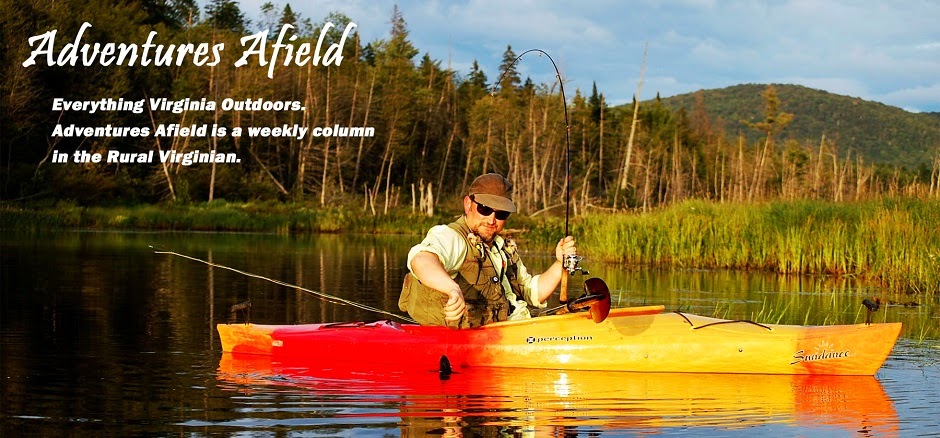Finally relaxed, nose mechanically plugged and eyes squeezed
closed, I pushed my hands past my ears and over my head, tracing the rim of the
cockpit for a nylon loop attached to my skirt. As quickly as I found it, I
formed a fist and ripped it over my head, twisting, pushing free, and bursting
from cold river water into a seasonably warm early fall afternoon.
 |
| Public Domain photo. |
Knee deep in slack water, the South Fork of the Holston
River dripped from my traumatized face. I had just completed my second ever
“wet-exit” from a whitewater kayak, as a prerequisite for my first run down one
of southwest Virginia’s domineering rivers. I was green, to say the least.
Whitewater kayaking, on all counts—from the construction and
maneuverability of the craft to the safety precautions and nature of the game—,
is a different sport entirely from flatwater kayaking or floating a moderate
river in a sit-on or sit-in boat. It’s a win-lose battle with hydrologic
currents in which every stroke, every tilt, every pressure point, is a decisive
action.
Luckily, there’s one hard-and-fast rule that I was
repeatedly offered—lean forward, paddle hard, even if you’re backwards.
Jim Harrison, Director of the Emory & Henry Outdoor
Program, whose boat I followed like a distressed duckling down the first rapid,
echoed this advice from ahead.
The first piece of whitewater I was up against was a choppy
rapid I would be tempted to dub a “narrow” as a fisherman. A multitude of large
rocks studded the riverbottom as the river’s width halved, resulting in a frothy
water slide 200 feet in duration.
From an upstream position, I did my best to center my weight
in the boat, lean forward, and dip short but powerful strokes at the bow,
managing to keep a straight course, even when falling into the holes behind
larger boulders. The bow would dip, get drawn down by tumbling water, and
pulled forward, until the hull met the system and bucked the whole craft
upright, and over the bulge, each rapid paddle stroke an anchor point.
Covered in spray and pumped with adrenaline, I battled
through to the tailout upright and oriented, until I hit the tailout, that is.
Relaxing, I must have put more weight on the left side of the seat, because the
bow swerved to the left while I still had a good amount of speed. Luckily, I
remembered to paddle, and saved myself from a coldwater swim.
A few hundred yards of flat water provided me opportunity to
practice. Consistently tracking a straight path remained a difficulty. I
couldn’t solve the left-hand spin.
Regardless, the next obstacle was up, this time, complete
with a belligerent name—“The Fist.”
The others in our party, seven students from the College,
took turns shooting the famed rapid, one at a time, each aiming to trace the
same “line” through the system.
When at last it was my turn, I was still skeptical of my
sub-novice ability’s suitability for the task at hand, but, determined to give
it my all, went forth anyway.
“The Fist” is a rather tight rapid, the safe and preferred
currents of which run tight to the right bank, under several overhanging tree
limbs, and finally through a choppy froth near the tail, which quickly meets an
outward jut in the bank.
Leaning forward and paddling hard, I managed to save myself
from flipping through to the end. Still, I had built up enough speed to make
the approaching jut dangerous. Human instincts being what they are, my eyes
were locked on the danger zone (a recommended practice when rowing a driftboat
or raft), influencing my balance and keeping me straight on towards collision.
Thankfully, I managed to shift my weight and avoid conflict with the trees.
Light was fading fast from the river valley as we approached
takeout. Only one obstacle was left to conquer. “Triple Drop” is a relatively
straightforward rapid, save for the three sudden drops of a few feet, and the
eddies that accent the current seams. Maintain a straight course, and avoid the
back eddies, and you’re golden.
I was second in line this time, behind a friend of mine. Our
line ran at first tight to the left bank, under overhanging limbs, then towards
the middle of the river where the drops started. Drop one spat me out
disoriented—sideways. A few paddle strokes corrected the issue, just in time to
take on the second.
However, at the last second, an eddy grabbed my bow and
swung me backwards. Still straight, although in reverse, I was pushed over the
second drop. The third drop came, and the story was the same—backwards, but
leaning forward, paddling hard. I landed intact, redirected my course, and
found takeout.
*Originally published in the Rural Virginian






